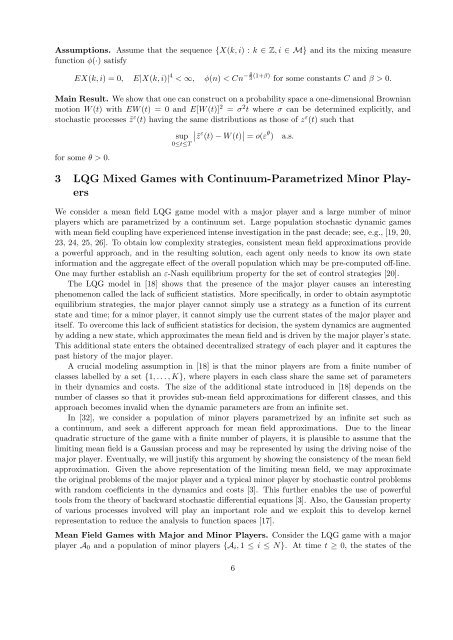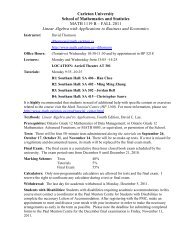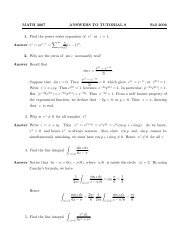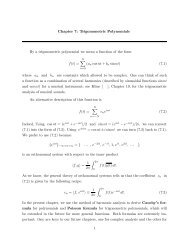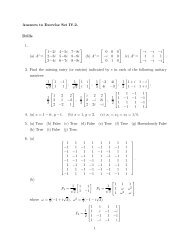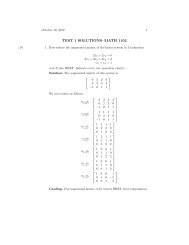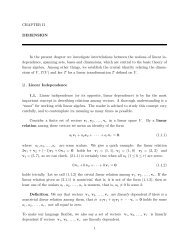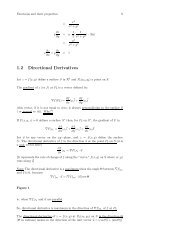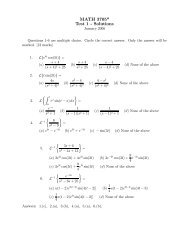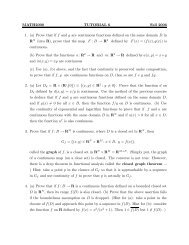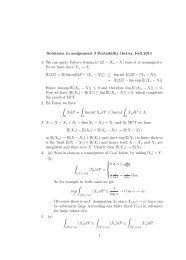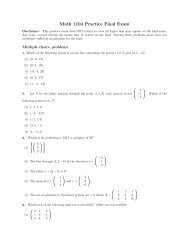Research Statement - Carleton University
Research Statement - Carleton University
Research Statement - Carleton University
You also want an ePaper? Increase the reach of your titles
YUMPU automatically turns print PDFs into web optimized ePapers that Google loves.
Assumptions. Assume that the sequence {X(k, i) : k ∈ Z, i ∈ M} and its the mixing measure<br />
function ϕ(·) satisfy<br />
EX(k, i) = 0, E|X(k, i)| 4 4<br />
−<br />
< ∞, ϕ(n) < Cn 3 (1+β) for some constants C and β > 0.<br />
Main Result. We show that one can construct on a probability space a one-dimensional Brownian<br />
motion W (t) with EW (t) = 0 and E[W (t)] 2 = σ 2 t where σ can be determined explicitly, and<br />
stochastic processes ˜z ε (t) having the same distributions as those of z ε (t) such that<br />
for some θ > 0.<br />
sup<br />
0≤t≤T<br />
<br />
<br />
ε<br />
˜z (t) − W (t) θ<br />
= o(ε ) a.s.<br />
3 LQG Mixed Games with Continuum-Parametrized Minor Players<br />
We consider a mean field LQG game model with a major player and a large number of minor<br />
players which are parametrized by a continuum set. Large population stochastic dynamic games<br />
with mean field coupling have experienced intense investigation in the past decade; see, e.g., [19, 20,<br />
23, 24, 25, 26]. To obtain low complexity strategies, consistent mean field approximations provide<br />
a powerful approach, and in the resulting solution, each agent only needs to know its own state<br />
information and the aggregate effect of the overall population which may be pre-computed off-line.<br />
One may further establish an ε-Nash equilibrium property for the set of control strategies [20].<br />
The LQG model in [18] shows that the presence of the major player causes an interesting<br />
phenomenon called the lack of sufficient statistics. More specifically, in order to obtain asymptotic<br />
equilibrium strategies, the major player cannot simply use a strategy as a function of its current<br />
state and time; for a minor player, it cannot simply use the current states of the major player and<br />
itself. To overcome this lack of sufficient statistics for decision, the system dynamics are augmented<br />
by adding a new state, which approximates the mean field and is driven by the major player’s state.<br />
This additional state enters the obtained decentralized strategy of each player and it captures the<br />
past history of the major player.<br />
A crucial modeling assumption in [18] is that the minor players are from a finite number of<br />
classes labelled by a set {1, . . . , K}, where players in each class share the same set of parameters<br />
in their dynamics and costs. The size of the additional state introduced in [18] depends on the<br />
number of classes so that it provides sub-mean field approximations for different classes, and this<br />
approach becomes invalid when the dynamic parameters are from an infinite set.<br />
In [32], we consider a population of minor players parametrized by an infinite set such as<br />
a continuum, and seek a different approach for mean field approximations. Due to the linear<br />
quadratic structure of the game with a finite number of players, it is plausible to assume that the<br />
limiting mean field is a Gaussian process and may be represented by using the driving noise of the<br />
major player. Eventually, we will justify this argument by showing the consistency of the mean field<br />
approximation. Given the above representation of the limiting mean field, we may approximate<br />
the original problems of the major player and a typical minor player by stochastic control problems<br />
with random coefficients in the dynamics and costs [3]. This further enables the use of powerful<br />
tools from the theory of backward stochastic differential equations [3]. Also, the Gaussian property<br />
of various processes involved will play an important role and we exploit this to develop kernel<br />
representation to reduce the analysis to function spaces [17].<br />
Mean Field Games with Major and Minor Players. Consider the LQG game with a major<br />
player A0 and a population of minor players {Ai, 1 ≤ i ≤ N}. At time t ≥ 0, the states of the<br />
6


